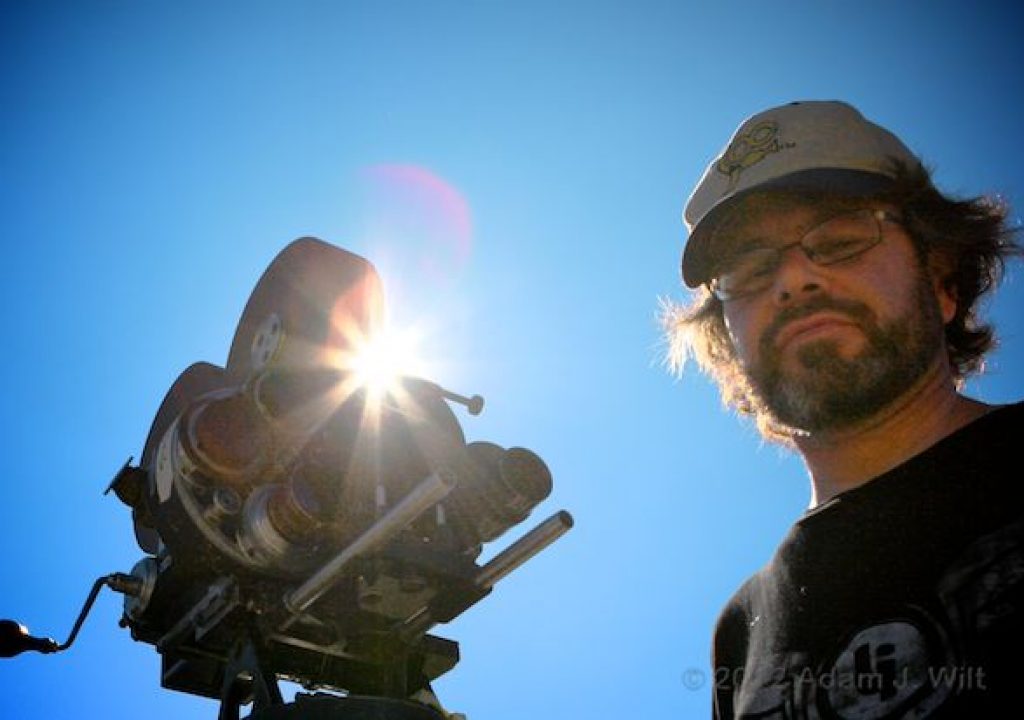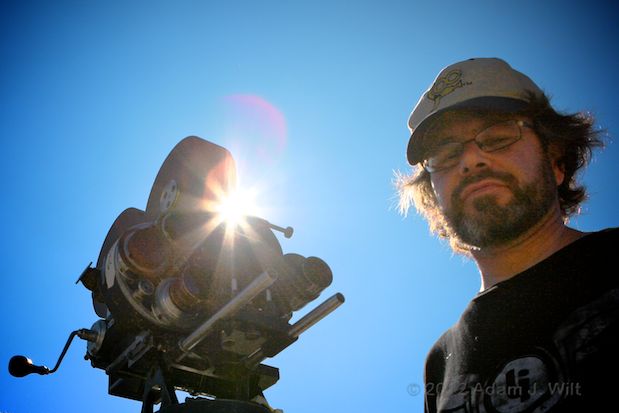
The Bell & Howell 2709 and 1st AC Art Adams.
This past weekend I had the privilege of observing a crew from the Niles Essanay Silent Film Museum as they filmed (yes, filmed) scenes for a silent movie, “The Canyon”, using a 1922 Bell & Howell 2709 hand-cranked 35mm camera—the first film camera not made of wood. Our own Art Adams is the 1st AC on this show, and these pictures complement his articles about it. I’ve got a quick overview of the camera, I’ll show what’s involved with loading the film, and close with a few snapshots of operating the 2709 and filming “The Canyon”.
Art wishes to emphasize that he’s not a 1st AC in real life: “I’m normally a DP but I’m revisiting my roots as a camera assistant. I’d rather people not think that I do it professionally. I literally haven’t done that job for money in 20 years, and it’s fun going back and playing but I don’t want to do it otherwise.”
He was even more emphatic last Monday morning, recovering from the weekend of early calls, heavy lifting, and late nights unloading magazines!
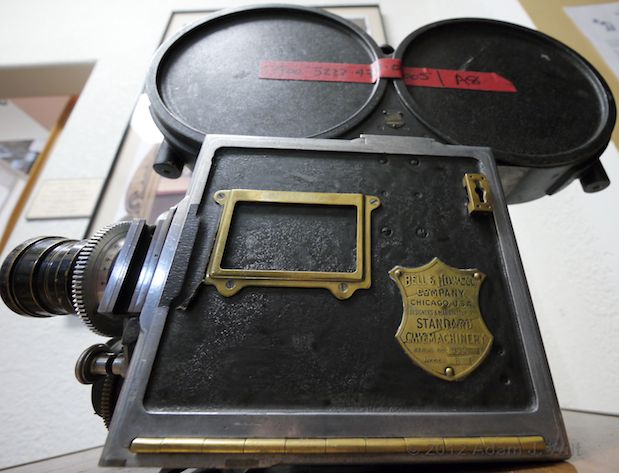
The Bell & Howell 2709 hand-cranked camera, hand-built in 1922.
The 2709 is a 90-year-old camera. It functions just as smoothly and precisely as if it had been made yesterday. This particular camera is owned and carefully maintained by film technology historian Sprague Anderson.
Design and Operation
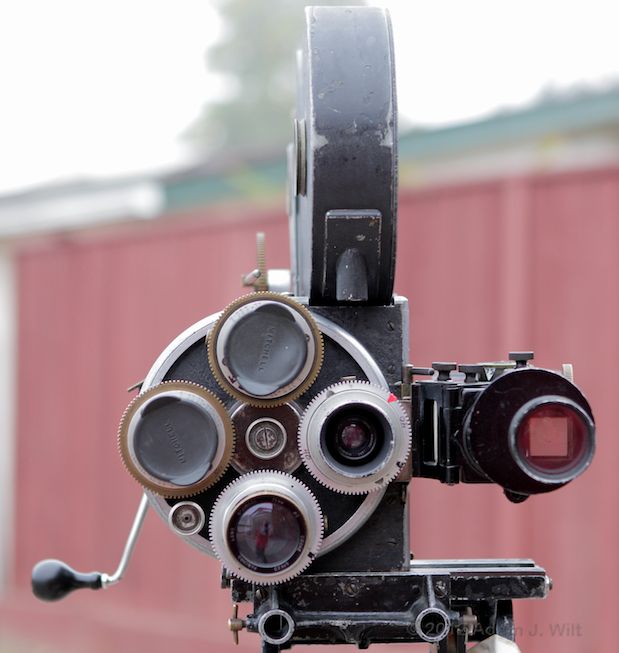
Bell & Howell 2709, front view.
The camera has a four-lens turret. The knob at the 7:30 position on the turret pulls out to unlock the turret and allow it to rotate. The lens at 3:00 is in taking position, in front of the film plane. The lens at 9:00 is in viewing position: there’s a small through-the-lens eyepiece behind it.
To the left, you can see the hand crank that serves in place of a motor.
To the right is the removable side finder, used during actual shooting as there’s no way to see through the lens in taking position. Removed from the camera, it’s handy for the operator to use as a “director’s finder”, to find the next shot before commanding the 1st AC to bring the camera over and set it up.
Observe that the sockets for the matte box support rods are mounted on the tripod head, not the camera’s base.
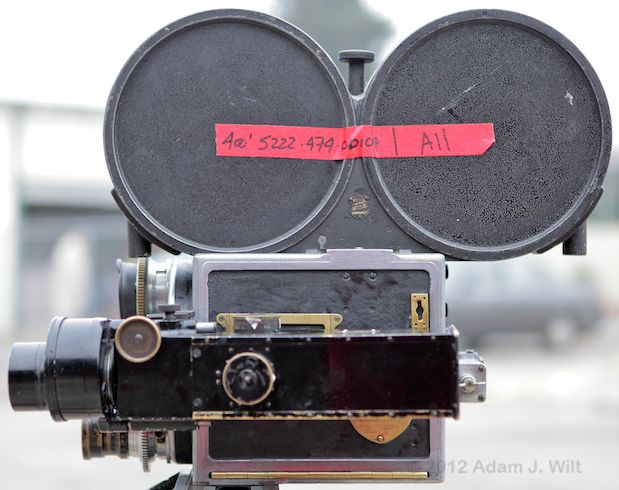
Bell & Howell 2709, left side.
The camera is surmounted with a 400-foot film magazine, secured with a knob running between the feed and takeup chambers (when screwed down, that knob also opens the magazine’s light-trap doors, allowing film to run freely). The lids to both sides of the mag are secured with a strip of camera tape, on which Art has written the load length, film type and emulsion batch number, and reel number.
The side finder runs the length of the camera. The large knob at its front focuses its 40mm lens; central knobs on the side and top set framelines. A lever at the front locks it into its mounting dovetail slot, and small knobs on the top front edge lock the focus and parallax settings.
There’s a piano-style hinge running along the bottom of the camera: with the finder removed, the entire side of the camera flips down to allow film threading.
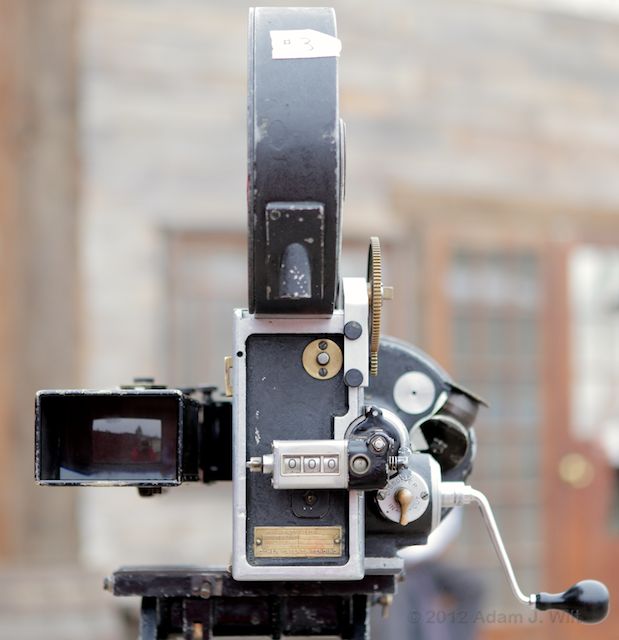
Bell & Howell 2709, rear view.
At the left, the side finder’s large viewing lens is visible. There’s an optional digital footage counter (mechanical, not electronic!) friction-fitted to a socket on the back of the camera; above that along the right side you can see the edge of the shutter-angle gears. The hand crank sticks out from the lower right side; behind it is the dissolver:
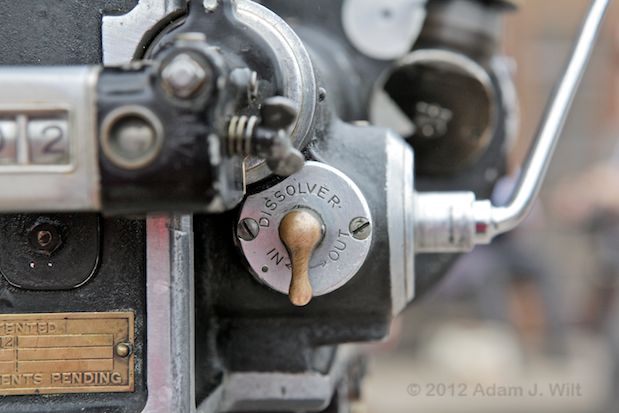
Dissolver: fixed-length (four feet) automatic fade-ins and fade-outs.
When you push the dissolver lever to the right (fade out) or left (fade in), it engages a clutch to drive the shutter angle control, closing or opening the variable shutter during the transport of four feet of film (at 16fps, and with 16 four-perf frames per foot, this gives a four-second effect time. However, since exposure varies the most while the shutter angle is the smallest, the fading of the image is most pronounced during the two seconds at the end of a fade out or the start of a dissolve).
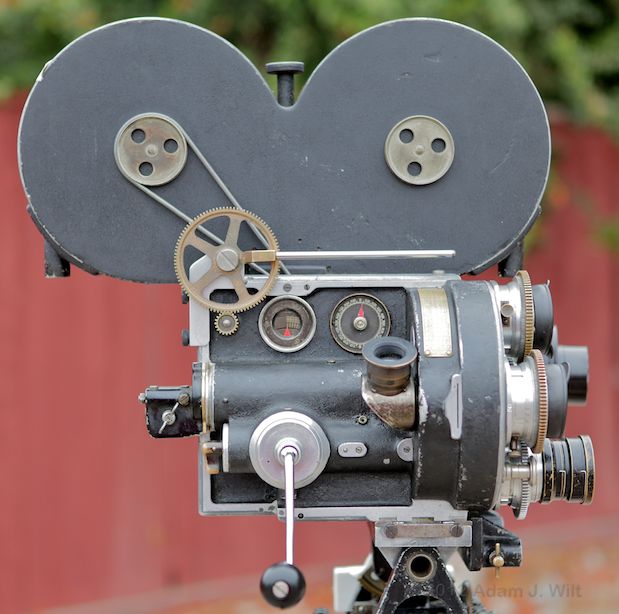
Bell & Howell 2709, right side.
On the right of the camera, the takeup spindle of the mag is driven by a coiled-spring belt drive. The spring is removed before removing the mag (of course!) and can also be given a half-twist and looped over the feed spindle’s pulley, to backwind film when performing in-camera dissolves or splitscreens.
Along the top of the body there’s a small shutter-angle gear, mated with a larger gear with a long silver lever attached. This is the manual shutter-angle lever; you can rotate it through 180º to vary the shutter from its fully-open 170º setting through fully-closed. Next to the gear is the shutter angle readout dial, and ahead of that there’s a rotary footage counter dial. Below the footage counter is the rotating eyepiece for the through-the-lens viewer; it lets you see through a lens in the viewing position (not the taking position, remember). A small slit between eyepiece and lens lets you slide in behind-the-lens mattes to preview effects (like heart or binocular vignettes) or splitscreens.
The eyepiece image is flipped left-to-right and has a pair of crosshairs etched into its groundglass: one for full-frame and one for Academy aperture.
The handcrank is removable; it simply snaps into its socket.
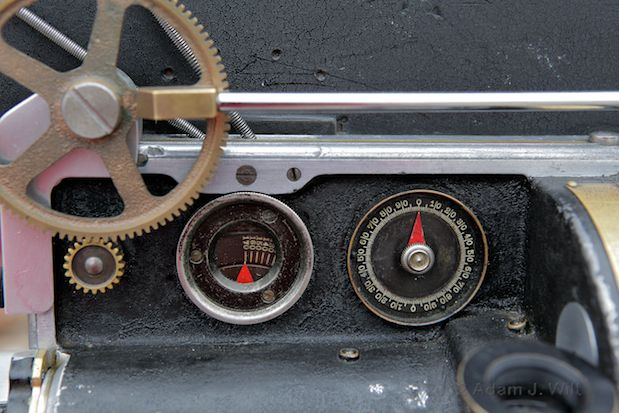
Right side detail: shutter angle setting gear and lever, shutter angle indicator, footage counter.
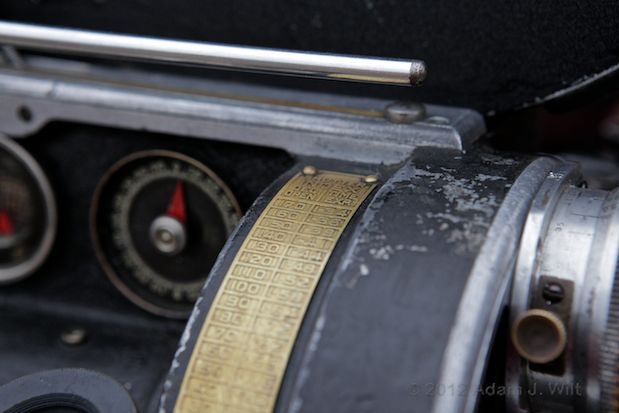
Exposure guide: shutter angle / exposure time table at 16fps.
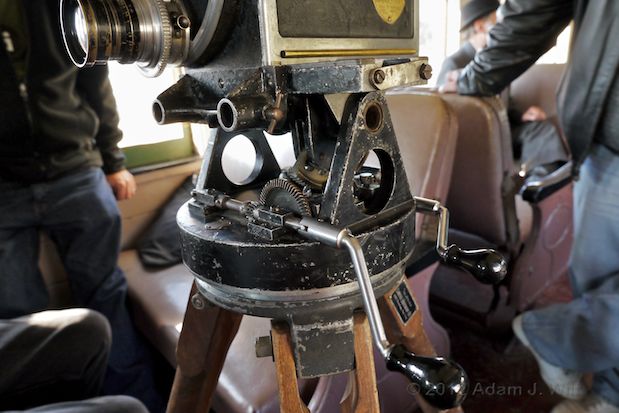
A period-appropriate Bell & Howell geared head.
The geared head is designed to position the camera for a take, more than move it during a shot. It has a single, fixed speed in both pan and tilt, and neither axis can be declutched. Quick panning and repositioning is accomplished by loosening the clamp beneath the tripod and spinning the entire head on its base. Fortunately it is not keyed to lock into a single position.
Note again that the iris rods mount to the head, not the camera. This allows the matte box with its mattes and filters to remain in place even as the camera is racked side-to-side between viewing and taking positions.
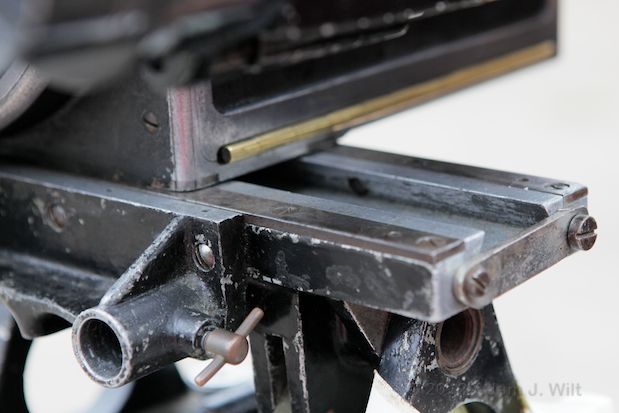
The rackover (lateral dovetail slider) lets the camera move between taking and viewing positions.
The lateral dovetailed channel is the “rackover”, allowing the camera, in essence, to slide behind its lens, so that the lens is in the same physical position with respect to the scene whether the camera has the lens in its viewing or taking position. This lets you see through the lens with perfect angular accuracy, without parallax error… except you just can’t look through the lens while actually filming!
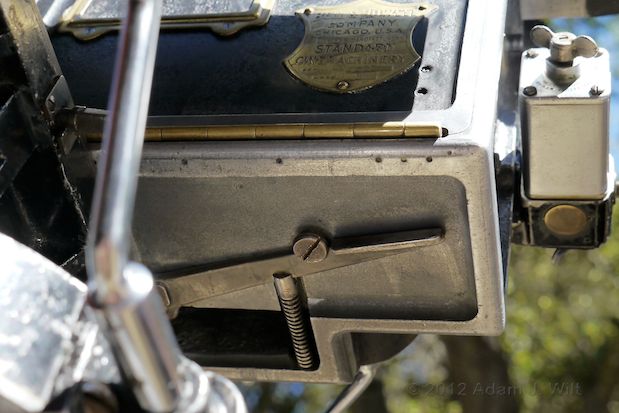
A spring clamp on the camera’s underside locks it in the rackover.
On the 2709, there’s a spring clamp securing the camera in the channel. To rack over, you squeeze this lever and slide the camera to the desired position.
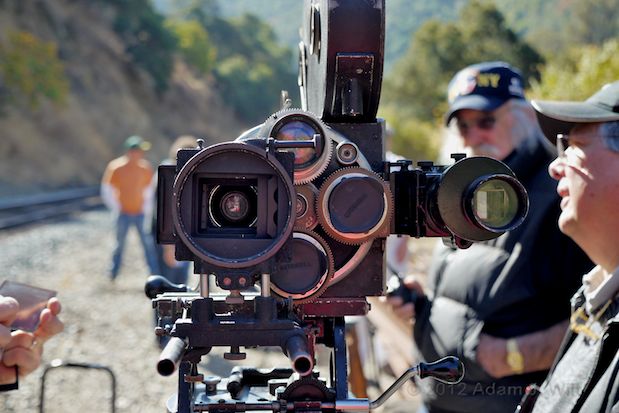
The camera racked over with the lens in viewing position.
Initially, the camera is set to viewing position, where it can be aimed through the filters and mattes in the matte box. This is the only time you can use through-the-lens viewing to gauge actual viewing angles, depth of field, and the effect of filters and mattes.
In this position, you’ll typically aim the camera at a stationary object at the same distance from the camera as the critical elements of your scene; you’ll line up the crosshairs in the eyepiece with that object, and then lock down the camera.
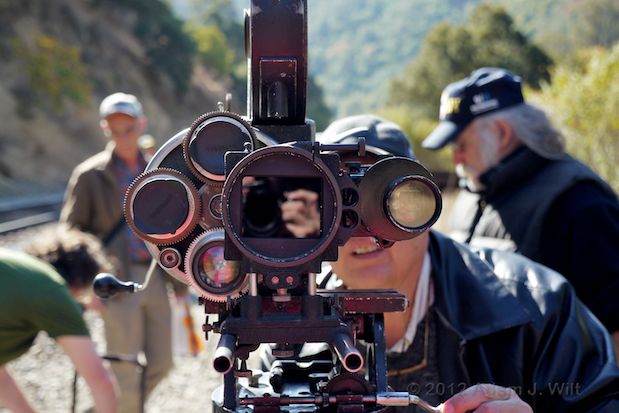
The camera racked over with the lens in taking position.
Next you’ll rack the camera over into taking position, and spin the lens turret 180º so that the lens you were viewing through is now in taking position (in the pix above, note that the release knob at 1:30 in viewing position is at 7:30 in taking position). You then loosen a knob on the side finder’s hinge mechanism, and aim it in or out as needed, adjusting its convergence until its crosshairs line up with that same stationary object you viewed through the lens. That sets the side finder’s parallax so that, at the subject distance for this shot, the side finder will be aimed at exactly the same point as the taking lens.
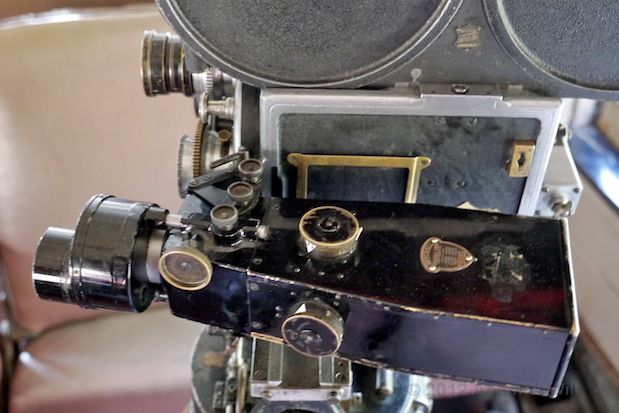
The side finder toes in to aim at the same subject as the taking lens is seeing.
Objects closer or farther than the subject plane will of course be displaced laterally due to parallax error, so you’ll have to keep this in mind while framing your shot.
Next, you’ll have to ensure that the side finder sees the same angle of view as your taking lens. Rather than using interchangeable optics or a varifocal lens, the side finder uses a wide-angle 40mm lens with movable framelines to crop down the image to the angle seen by longer lenses.
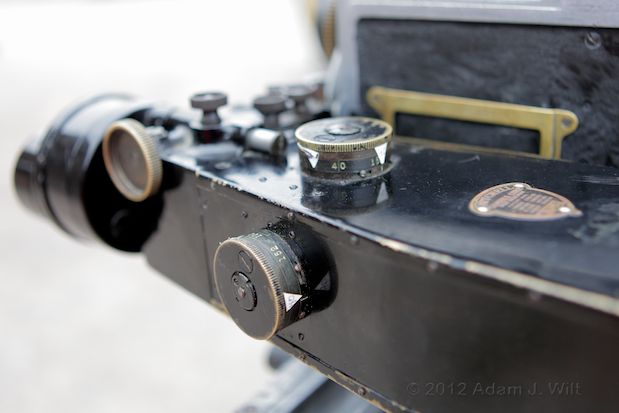
Side finder frameline setting knobs.
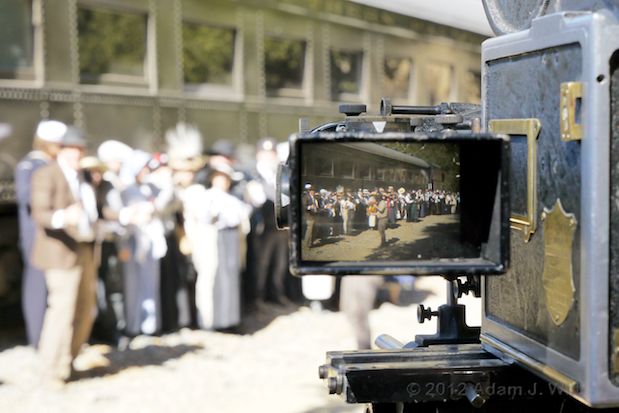
The side finder, with framelines retracted to their widest, 40mm position.
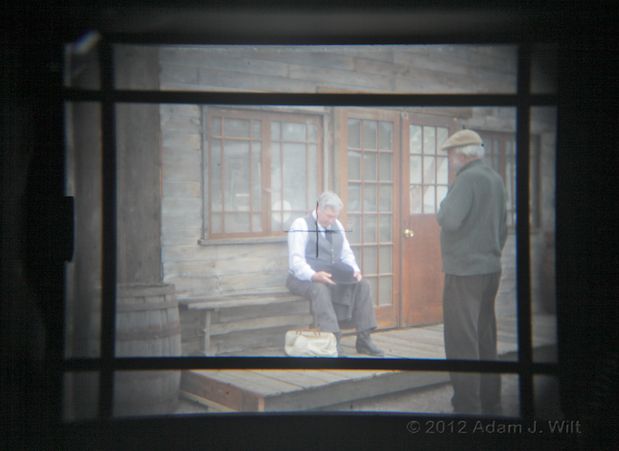
View through side finder with framelines set for a 50mm lens.
During this weekend’s shoot, wide shots were made at 40mm with the 50mm used to punch in for close details. Extreme telephoto shots were made with a 75mm—but “zooming with your feet” was the modus operandi of the day, and Art got plenty of exercise hoisting the tripod-mounted camera on his shoulder and walking it from place to place.
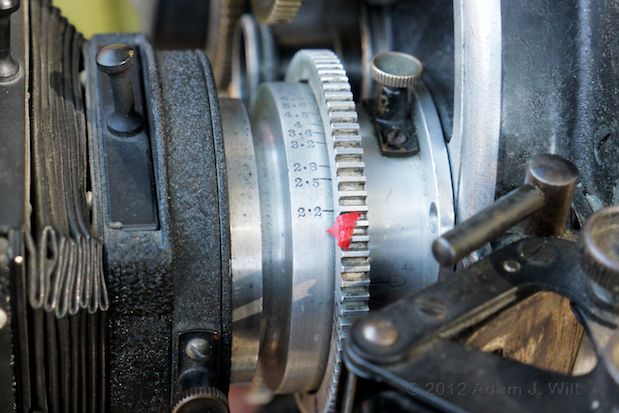
90-year-old lens markings and focus gearing.
Lens ergonomics of 1922 weren’t what they are today. Still: these lenses and the camera they’re mounted to are working flawlessly nearly a century later, a testament to early 20th century craftsmanship and engineering.
Next: unloading and reloading a film magazine in broad daylight
Unloading and reloading a film magazine in broad daylight
A 400-foot roll of 4-perf 35mm film lasts 400 seconds at 16fps, or six and two-thirds minutes. Film changes are frequent. To allow the film to be handled without a darkroom, Art uses a changing bag: a double-layered, light-tight cloth bag big enough to hold a magazine and a roll of film. Dual zippers open in opposite directions, to minimize the chance of a light leak even if they aren’t fully closed. The changing bag has two sleeves with elastic cuffs; after zipping film and mag in the bag, Art sticks his hands into the sleeves to work with the film entirely by touch.
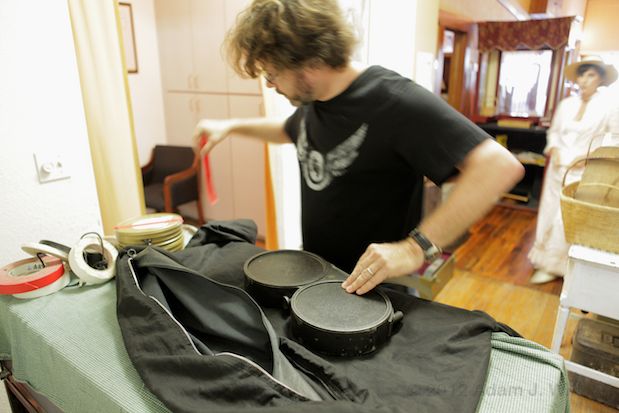
Art preps a magazine for unloading.
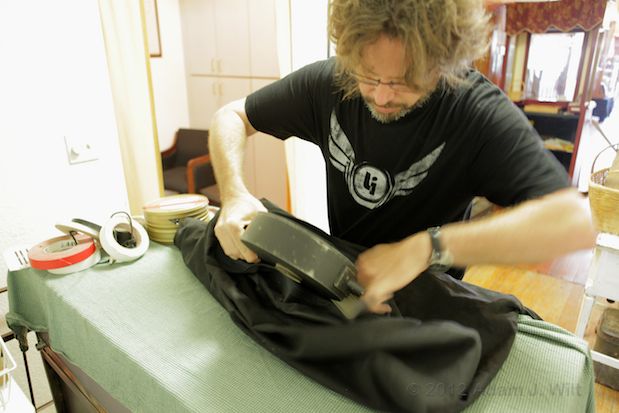
The magazine is placed into the changing bag.
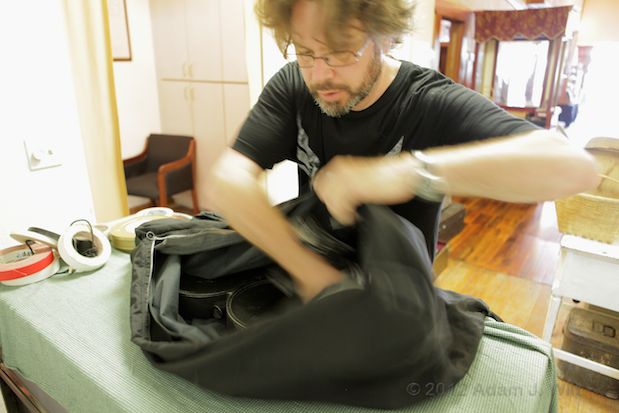
An empty film can is inserted to receive the exposed footage.
There’s also a small aluminum doodad that the magazine’s top knob screws into, opening the light trap doors as if the mag were screwed to a camera. That doodad goes into the bag, too; without it, the mag’s doors remain tightly shut, and the AC won’t be able the thread the film through the light traps.
Many more modern mags don’t use doors on the light traps; instead they have a labyrinthine path through narrow (often felt-lined) slits to block the light, and no such doodad is needed.
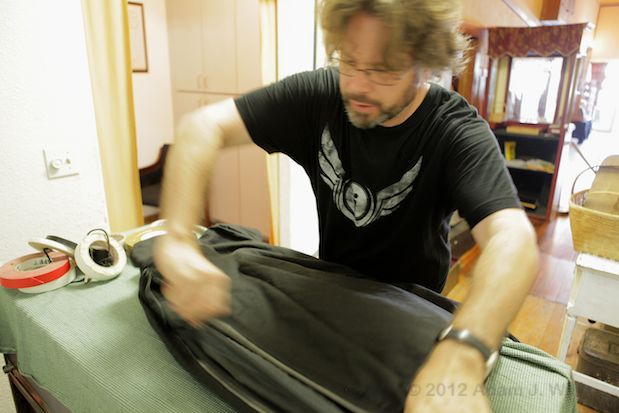
Art zips up the inner liner of the changing bag…
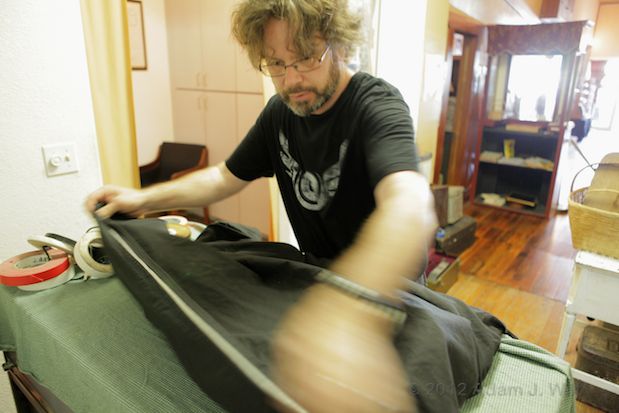
…and the outer cover, zipped in the opposite direction.
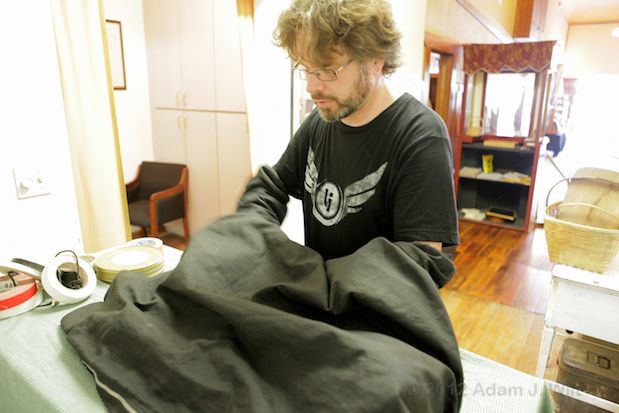
Art sticks his hands in the elastic sleeves, and unloads the mag.
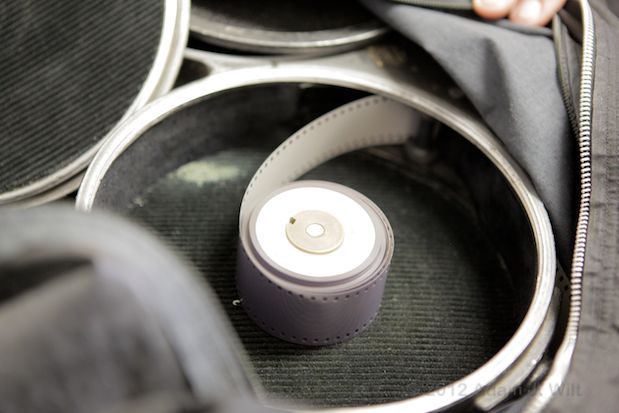
Short end, left behind on a core.
This happens when the mag hasn’t been “run out”; if there’s a lot of film left (in 35mm, typically 100 feet or more), it’s recanned for later use, but in this case, it was only a few feet, not enough to be useful.
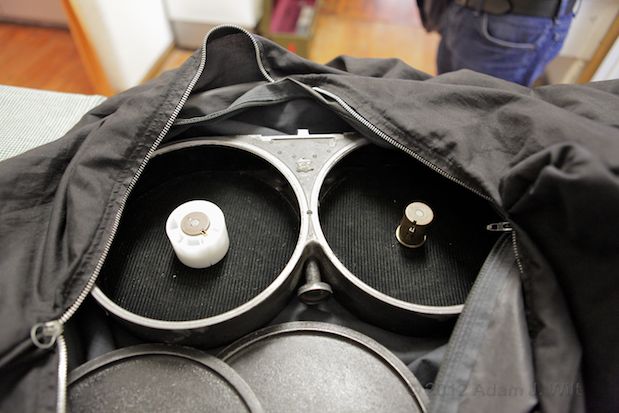
The core, stripped of the leftover film, is placed on the takeup spindle.
After unloading the exposed film, the empty core is moved from the feed side to the takeup side, and a fresh roll of unexposed film is placed in the bag for loading.
(Yes, it can be a little bit quicker to unload and reload the mag in one go—which is how I was taught to do it—instead of doing the two operations in separate passes, but it increases the chances of dumb mistakes, like loading the exposed film right back into the mag and sending the unexposed fresh film to the lab for processing! Fortunately, I never made this particular error… but I worried about it constantly!)
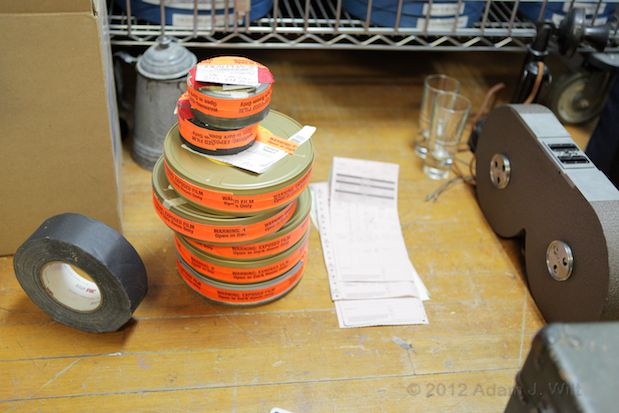
400-foot and 100-foot loads ready for the lab.
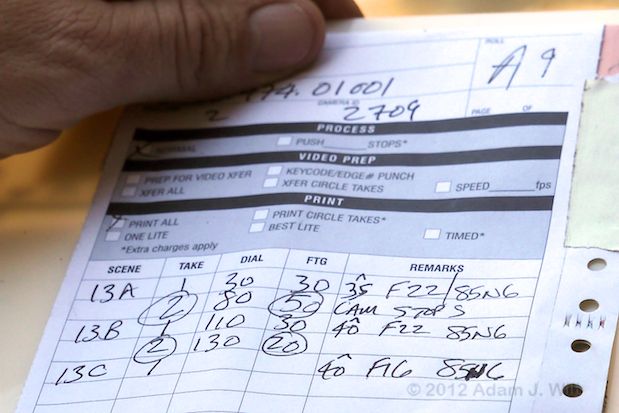
A typical camera report.
The camera report or camera log lists all the takes on the reel, along with the footage count at the end of the shot (usually rounded to the nearest ten feet), the footage consumed during the shot, and any notes (Art usually logs the lens and filter settings). Good takes are circled.
Next: Working with the 2709…
Working with the 2709
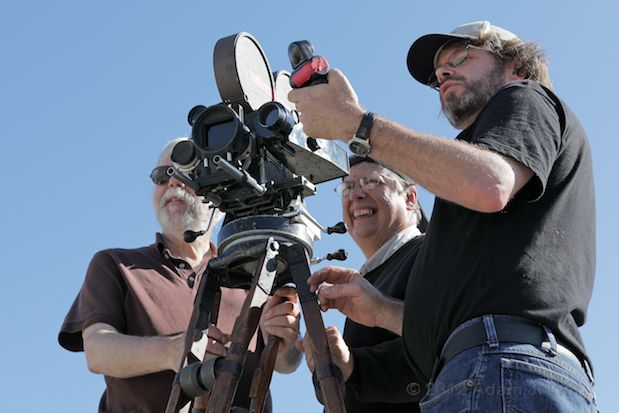
3-man crew: Sprague Anderson, DP Steve Kotton, and Art Adams.
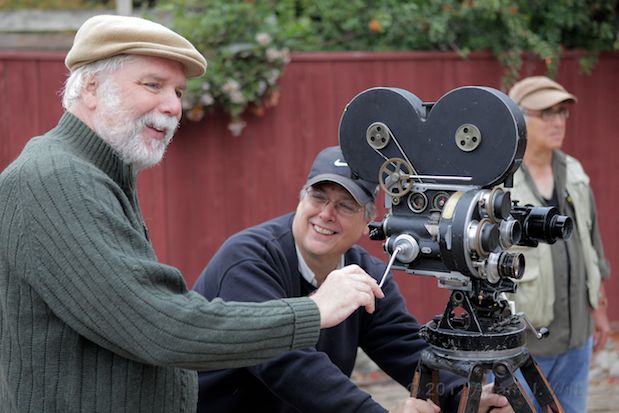
Sprague Anderson cranks while Steve Kotton operates.
Director David Keihn is on the right side of the image. He is an author, a film historian, and Niles Essanay’s Museum Manager.
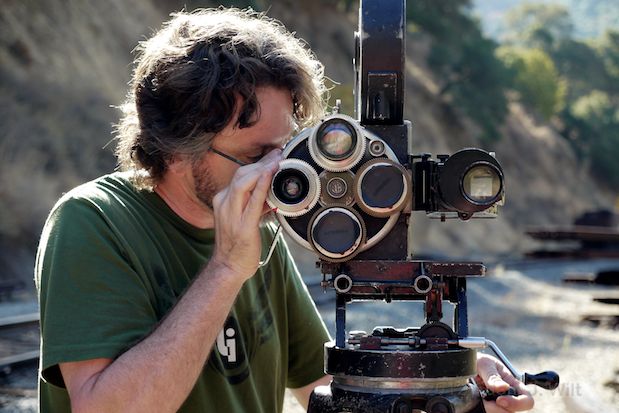
Art uses the reflex eyepiece to see through the lens in viewing position.
In this case, Art isn’t racked over to viewing position; he’s simply checking critical focus. The camera doesn’t care what position it’s in; you can always spin the turret ’round to look through a lens if you’re not concerned about it being offset from the taking position.
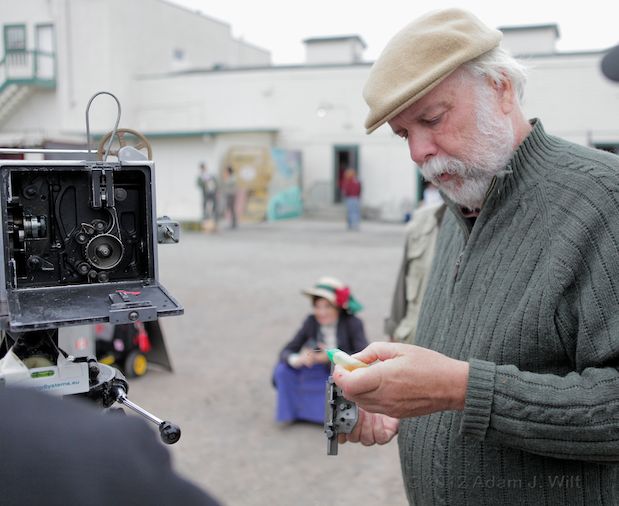
Between setups, Sprague checks, cleans, and lubes the gate.
A camera doesn’t get to be 90 years old unless it’s taken care of.
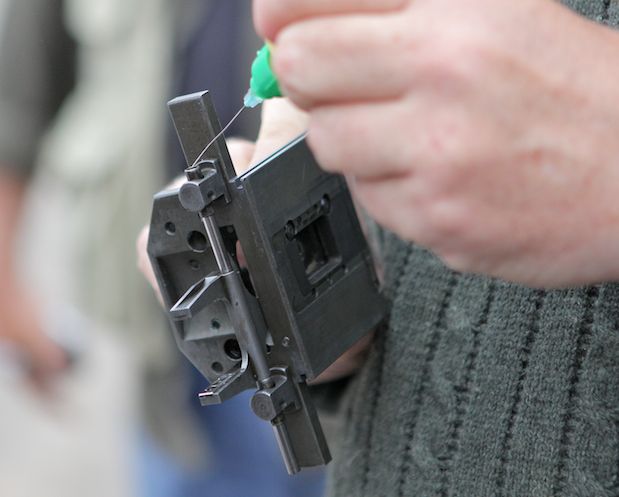
Oiling the slider of the pulldown mechanism.
This sliding part of the system is the film pulldown itself; the two protruding arms ride on a cam within the camera body. A separate cam follower (hidden in this image) lifts the film away from the film plane and lets it back down again.
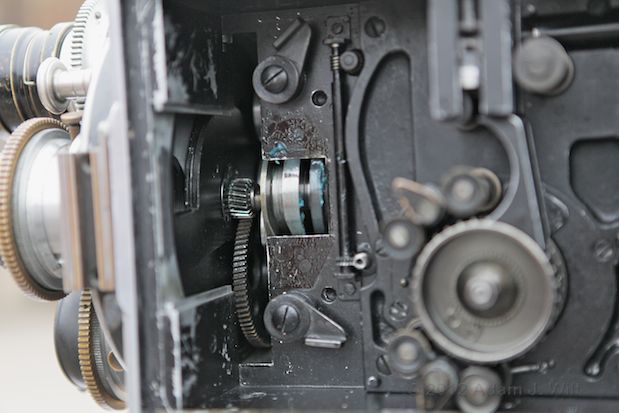
The gate assembly plugs in here.
You can see the two shutter disks in the front of the camera. Normally they spin together, but if you change the shutter angle, the disks rotate with respect to each other, closing down the shutter opening.
The silver cylinders centered in the image, liberally bedaubed with blue grease, are the cams that operates the pulldown mechanism in the gate.
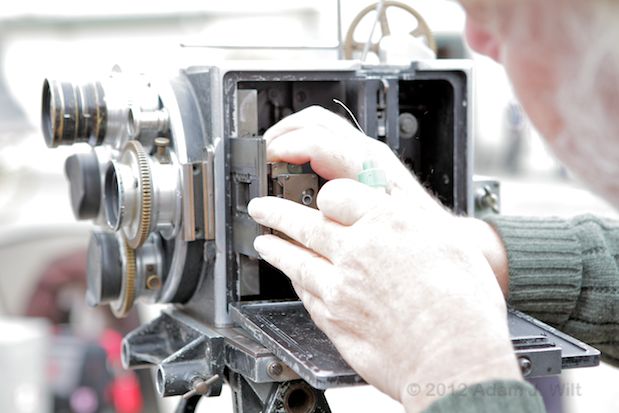
Reinserting the gate assembly into the camera.
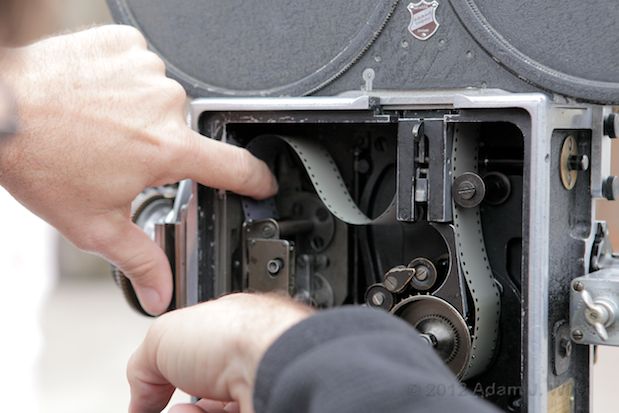
Art slides the film into the gate, feeling for the pins.
The trick with the 2709 is threading the gate so that the film’s perforations align with the registration pins. Otherwise, the pins will make new perfs when the film is advanced; this is not recommended!
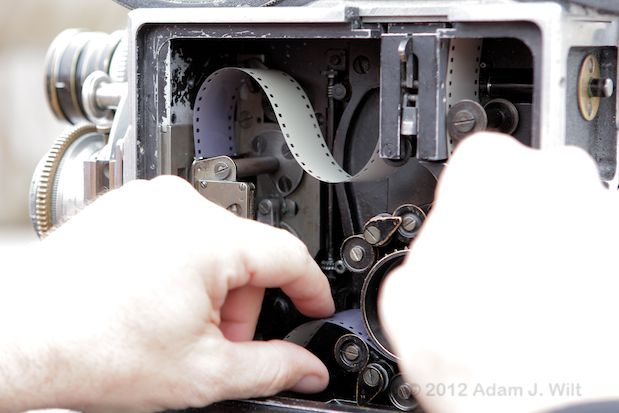
Wrapping the film ’round the takeup side of the drive sprocket.
Art comments, “the trick with loading this camera and other cameras, like Mitchells and Panaflex cameras, is that you thread them in reverse: film goes around take up side first, then through the gate, and then around the feed side. Not sure why this is, although I suspect the feed loop is more important than the take up loop so it gets set last.”
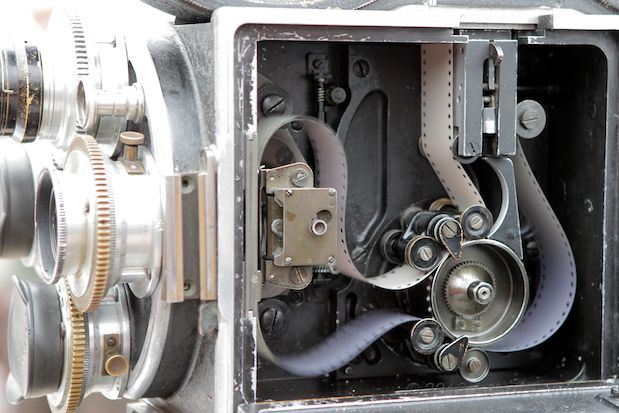
Testing for proper film transport before closing the camera up.
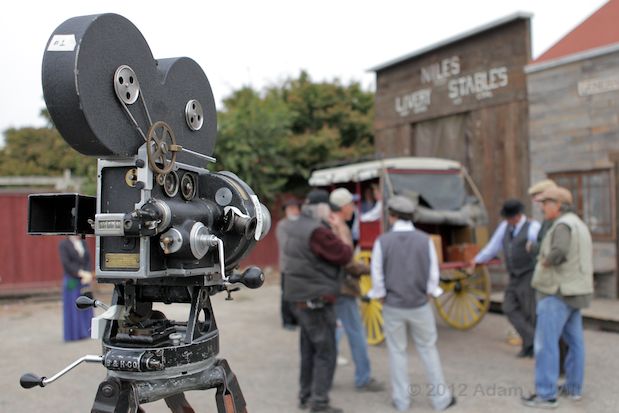
The 2709 ready for another shot.
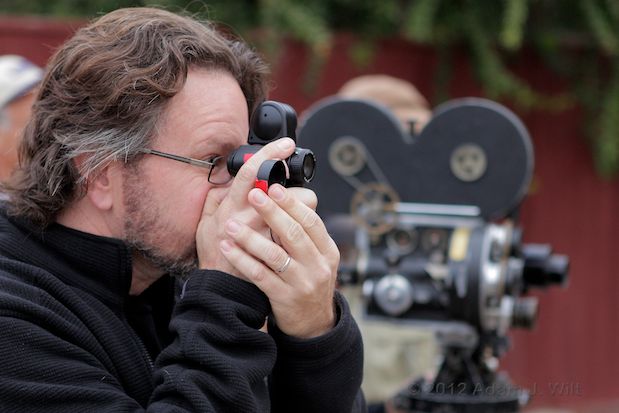
Art checks exposure, his light meter more essential on this shoot than is usual these days.
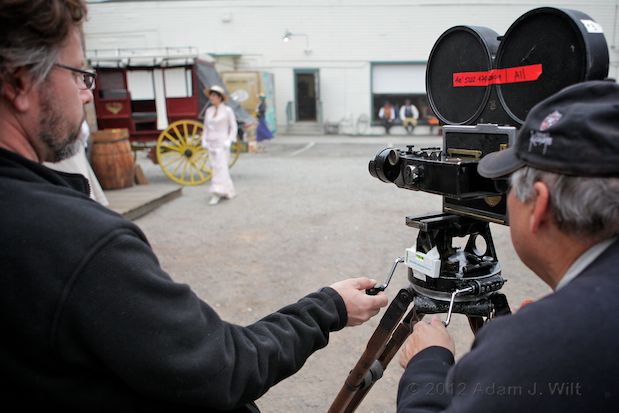
Camera crew: Steve pans while Art tilts.
Sometimes it’s handy to have a person per axis for realtime moves on this old gear head.
Next: “The Canyon”
A few “Canyon” production stills
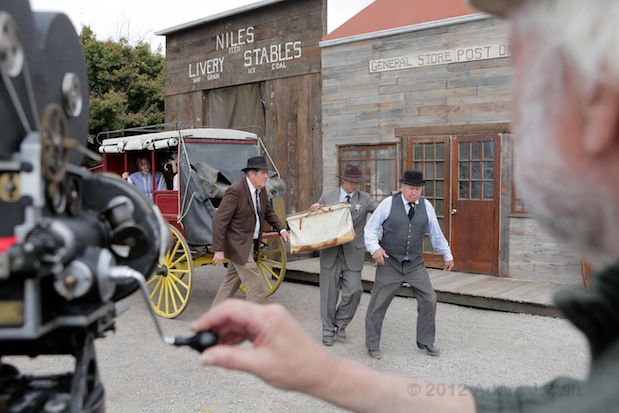
Sprague cranks as Broncho Billy and the Sheriff apprehend Clarence.
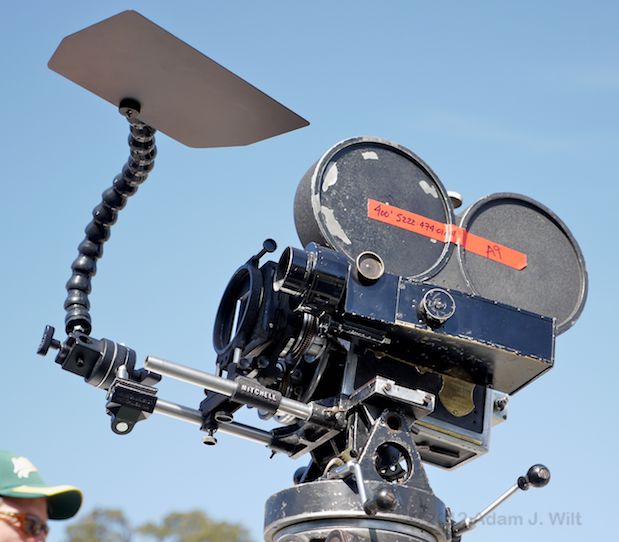
Anachronism: modern french flag, ancient camera.
I’m afraid this was my fault: I borrowed this flag from a documentary chap with a Canon XL-H1. It kept sun out of the lens, and I didn’t get thrown off the set, so I’m guessing the practical value outweighed the aesthetic outrage.
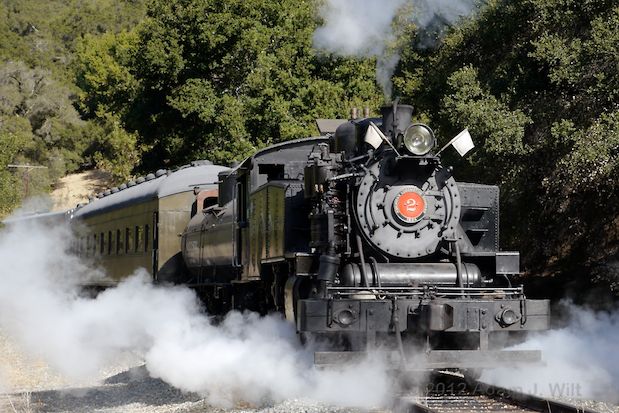
The steam train arrives, laden with bandits and their victims.
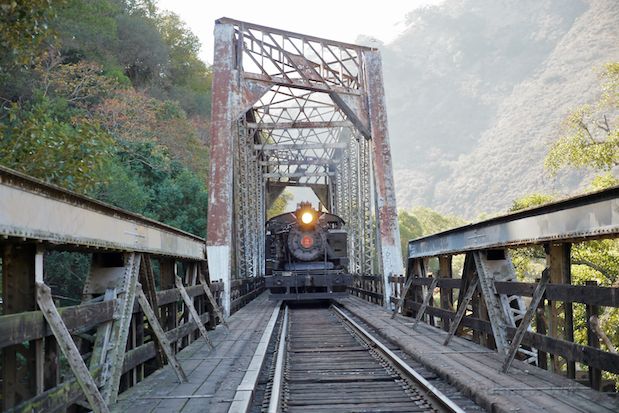
View from the railcar “speeder” as the steam engine hauls up the grade.
Four of us wound up on a “speeder”, an unsprung utility flatcar, to precede the steam train for a traveling shot. The steel wheel on the steel rail, unsuspended by the steel spring, is not the smoothest way to travel. This is one of the few shots I got that wasn’t horribly blurred. As to the 2709, it had its rear-mounted footage counter and the shutter-angle lever shaken loose by the vibration, but it kept on cranking (and no permanent damage was done; no parts went overboard!).
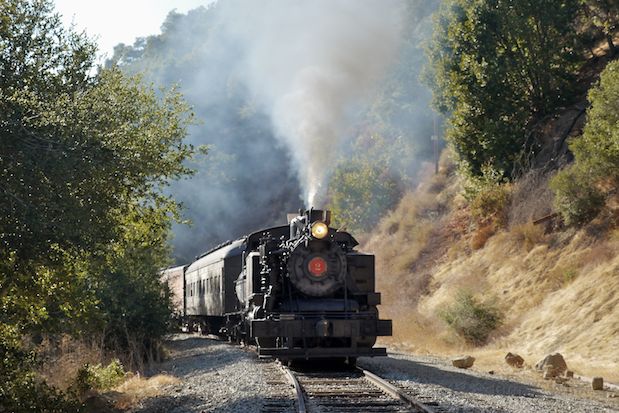
Coming ’round the bend.
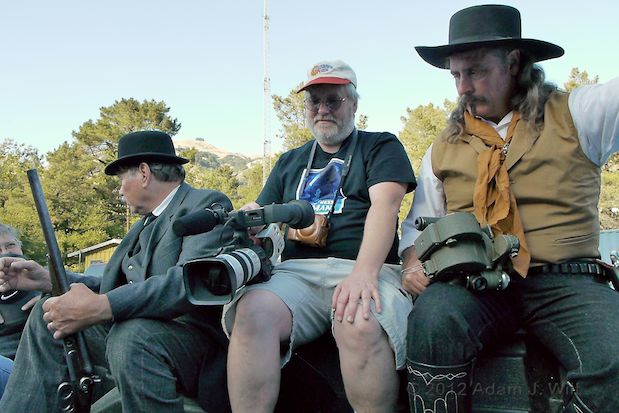
Loaded for bear: double-barreled shotgun, Canon XL-H1, Bell & Howell Eyemo (circa 1929).
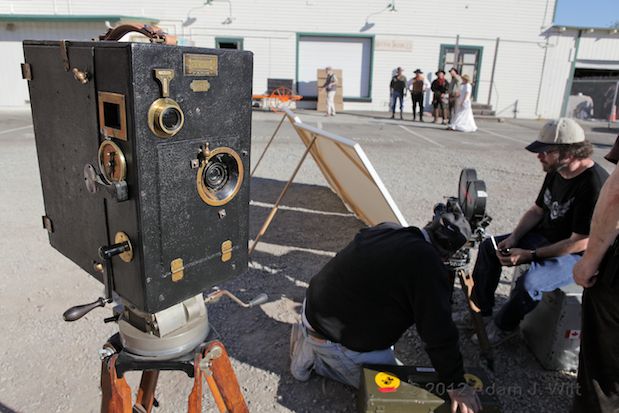
A Path© Bros. 35mm camera, made 1910-1920. Wood, leather, and brass.
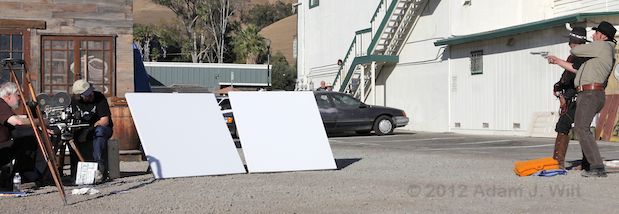
Shooting the shootout.
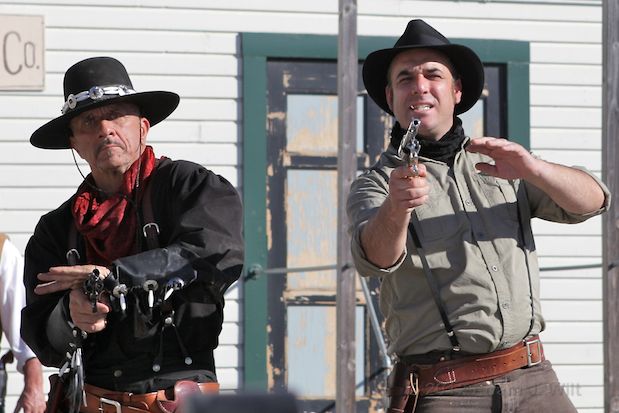
Two desperadoes in a showdown with the Sheriff.
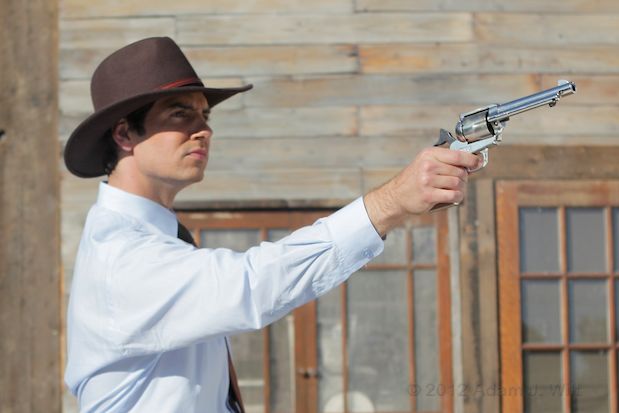
The Sheriff, ever cool, takes aim at the bad guys.
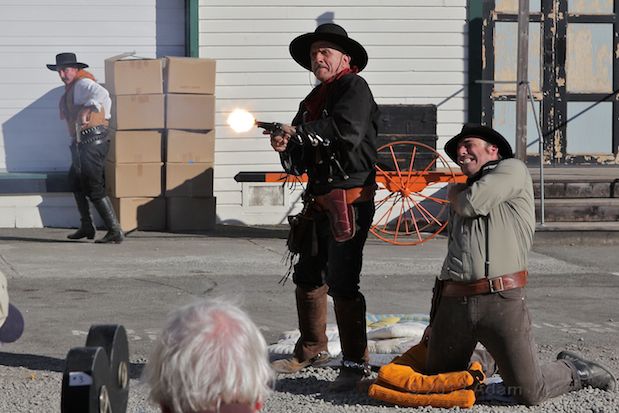
Eli takes one in the shoulder as Zander returns fire.
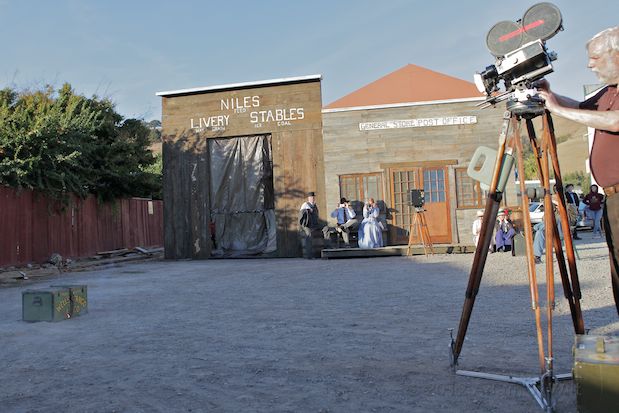
Blowing the strongbox: the flaming fuse is just visible at the base of the box.
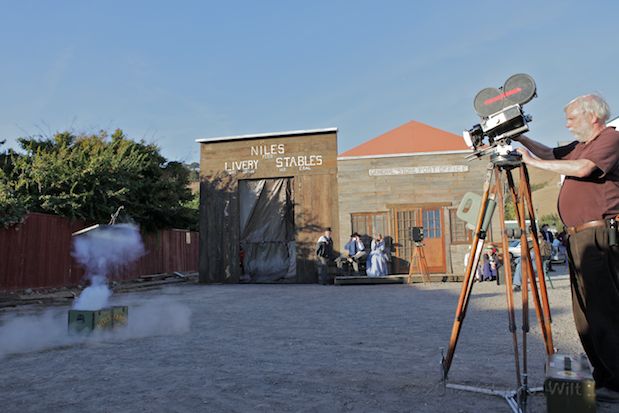
The lid blows off with a loud report and much smoke.
If you’re hungry for more, I have about 320 pictures posted on my website. Enjoy.
Disclosure: No material connection exists between me and the Niles Essanay Silent Film Museum. No one has offered any payments, freebies, or other blandishments in return for a mention or a favorable review.
Many thanks to the cast and crew of “The Canyon” for allowing me to document a weekend of shooting.

Filmtools
Filmmakers go-to destination for pre-production, production & post production equipment!
Shop Now